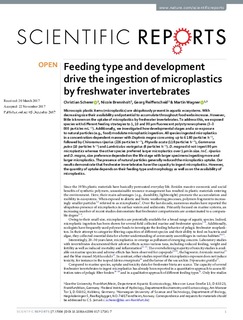| dc.contributor.author | Scherer, Christian | |
| dc.contributor.author | Brennholt, Nicole | |
| dc.contributor.author | Reifferscheid, Georg | |
| dc.contributor.author | Wagner, Martin | |
| dc.date.accessioned | 2018-08-24T09:20:08Z | |
| dc.date.available | 2018-08-24T09:20:08Z | |
| dc.date.created | 2018-01-18T13:19:32Z | |
| dc.date.issued | 2017 | |
| dc.identifier.citation | Scientific Reports. 2017, 7 (1), 1-9. | nb_NO |
| dc.identifier.issn | 2045-2322 | |
| dc.identifier.uri | http://hdl.handle.net/11250/2559195 | |
| dc.description.abstract | Microscopic plastic items (microplastics) are ubiquitously present in aquatic ecosystems. With decreasing size their availability and potential to accumulate throughout food webs increase. However, little is known on the uptake of microplastics by freshwater invertebrates. To address this, we exposed species with different feeding strategies to 1, 10 and 90 µm fluorescent polystyrene spheres (3–3 000 particles mL−1). Additionally, we investigated how developmental stages and a co-exposure to natural particles (e.g., food) modulate microplastic ingestion. All species ingested microplastics in a concentration-dependent manner with Daphnia magna consuming up to 6 180 particles h−1, followed by Chironomus riparius (226 particles h−1), Physella acuta (118 particles h−1), Gammarus pulex (10 particles h−1) and Lumbriculus variegatus (8 particles h−1). D. magna did not ingest 90 µm microplastics whereas the other species preferred larger microplastics over 1 µm in size. In C. riparius and D. magna, size preference depended on the life stage with larger specimens ingesting more and larger microplastics. The presence of natural particles generally reduced the microplastics uptake. Our results demonstrate that freshwater invertebrates have the capacity to ingest microplastics. However, the quantity of uptake depends on their feeding type and morphology as well as on the availability of microplastics. | nb_NO |
| dc.language.iso | eng | nb_NO |
| dc.publisher | Nature Publishing Group | nb_NO |
| dc.rights | Navngivelse 4.0 Internasjonal | * |
| dc.rights.uri | http://creativecommons.org/licenses/by/4.0/deed.no | * |
| dc.title | Feeding type and development drive the ingestion of microplastics by freshwater invertebrates | nb_NO |
| dc.type | Journal article | nb_NO |
| dc.type | Peer reviewed | nb_NO |
| dc.description.version | publishedVersion | nb_NO |
| dc.source.pagenumber | 1-9 | nb_NO |
| dc.source.volume | 7 | nb_NO |
| dc.source.journal | Scientific Reports | nb_NO |
| dc.source.issue | 1 | nb_NO |
| dc.identifier.doi | 10.1038/s41598-017-17191-7 | |
| dc.identifier.cristin | 1546322 | |
| dc.description.localcode | © The Author(s) 2017. This article is licensed under a Creative Commons Attribution 4.0 International License. | nb_NO |
| cristin.unitcode | 194,66,10,0 | |
| cristin.unitname | Institutt for biologi | |
| cristin.ispublished | true | |
| cristin.fulltext | original | |
| cristin.qualitycode | 1 | |

